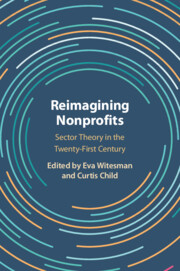Book contents
- Reimagining Nonprofits
- Reimagining Nonprofits
- Copyright page
- Contents
- Figures
- Tables
- Contributors
- Acknowledgments
- 1 An Invitation to Rethink the Nonprofit Sector
- Part I Overviews
- Part II Reflections and Refinements
- 5 Sector Theorists Should Consider How Social Values Determine Unmet Needs
- 6 Sector Theorists Should Embrace a Social Economy Perspective
- 7 Sector Theorists Should Expand Three-Failures Theory to Include the Family Sector and Varied Forms of Government
- 8 Sector Theorists Should Be Wary of the Nonprofit Industrial Complex
- 9 Sector Theorists Should Be Inclusive of Muslim and Non-Western Perspectives
- 10 Sector Theorists Should Revisit the Role of Information
- 11 Sector Theorists Should Borrow Epistemologies
- Part III New Directions
- Part IV Conclusion
- Index
- References
10 - Sector Theorists Should Revisit the Role of Information
from Part II - Reflections and Refinements
Published online by Cambridge University Press: 11 January 2024
- Reimagining Nonprofits
- Reimagining Nonprofits
- Copyright page
- Contents
- Figures
- Tables
- Contributors
- Acknowledgments
- 1 An Invitation to Rethink the Nonprofit Sector
- Part I Overviews
- Part II Reflections and Refinements
- 5 Sector Theorists Should Consider How Social Values Determine Unmet Needs
- 6 Sector Theorists Should Embrace a Social Economy Perspective
- 7 Sector Theorists Should Expand Three-Failures Theory to Include the Family Sector and Varied Forms of Government
- 8 Sector Theorists Should Be Wary of the Nonprofit Industrial Complex
- 9 Sector Theorists Should Be Inclusive of Muslim and Non-Western Perspectives
- 10 Sector Theorists Should Revisit the Role of Information
- 11 Sector Theorists Should Borrow Epistemologies
- Part III New Directions
- Part IV Conclusion
- Index
- References
Summary
The theory of the nonprofit institutional form introduced by Henry Hansmann more than 40 years ago proposed that informational problems, specifically information asymmetry, explains the essential defining feature of the nonprofit organization – the so-called nondistribution constraint. While the conventional argument holds that an asymmetry of information arises due to intrinsic, hard-to-measure attributes of nonprofit outputs, this chapter argues instead that informational problems arise because private purchasers fail to sufficiently value the positive externalities of information. In short, information is a social good, rather than a private good, and neither purchasers (donors) nor producers (nonprofits) have sufficiently strong incentives to systematically incur the costs and risks associated with generating information. The undervaluing of information by private parties results in a symmetry of ignorance that may lead to “benefit failure” in the form of foregone social impact. This type of failure is induced by transaction, allocative, and production inefficiencies resulting from the symmetry of ignorance.
Keywords
- Type
- Chapter
- Information
- Reimagining NonprofitsSector Theory in the Twenty-First Century, pp. 191 - 214Publisher: Cambridge University PressPrint publication year: 2024

